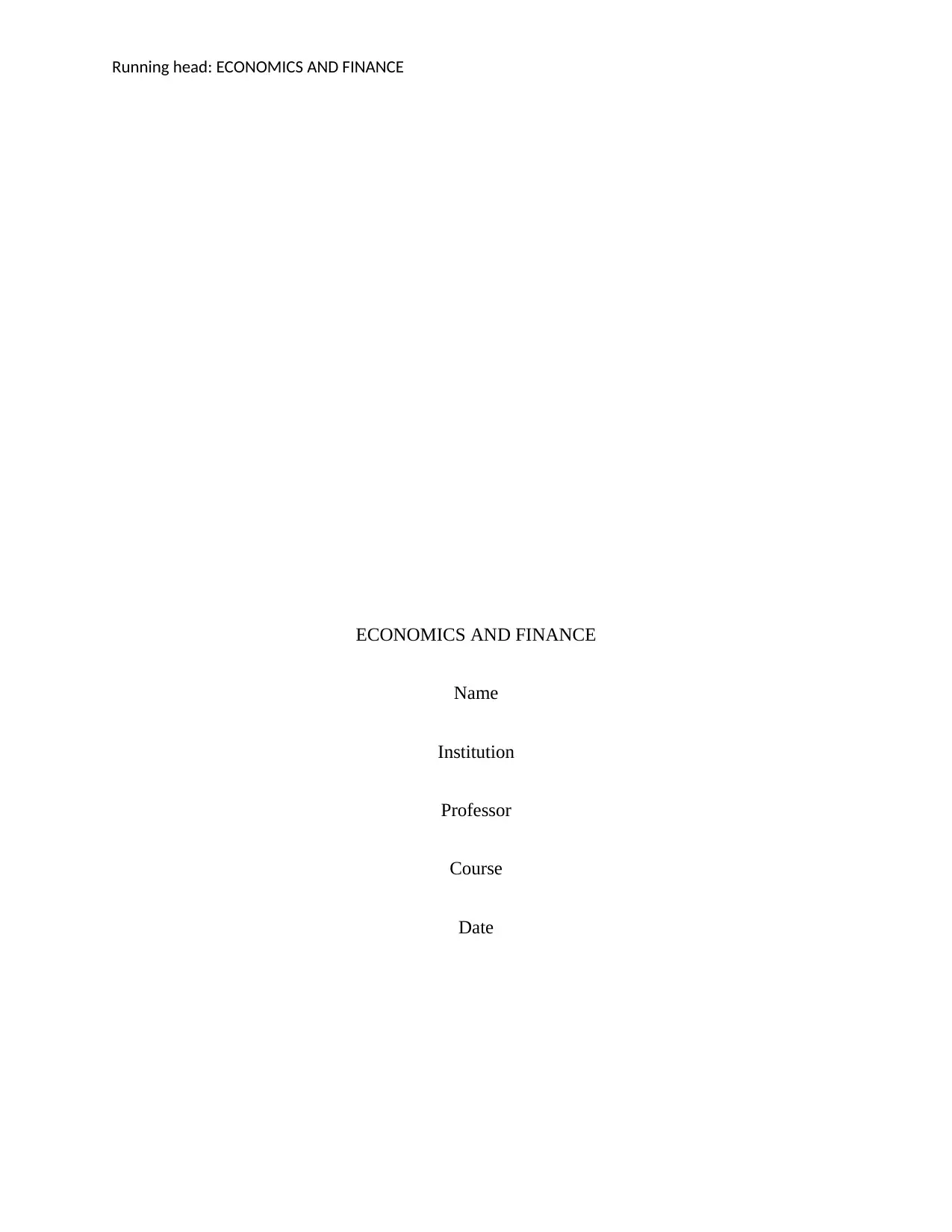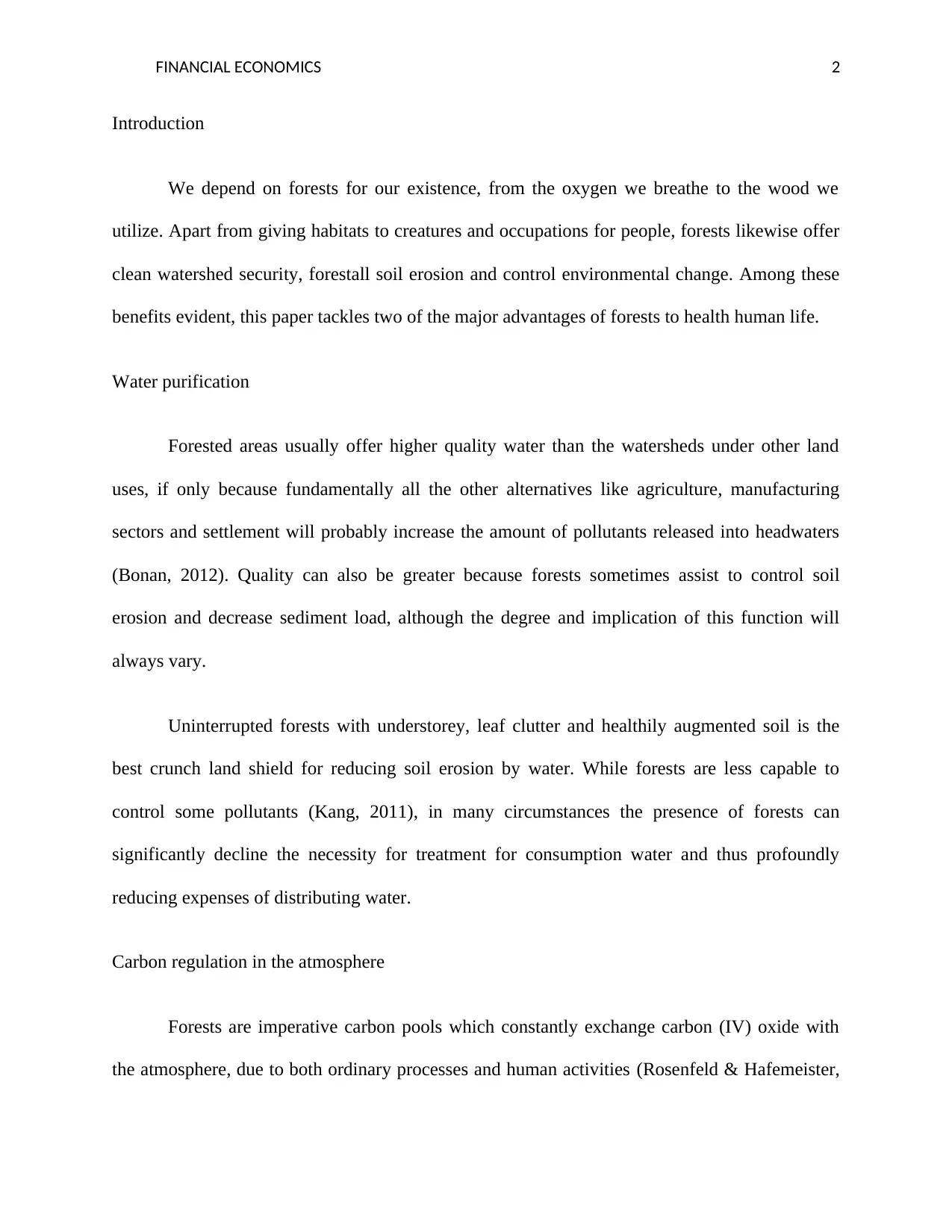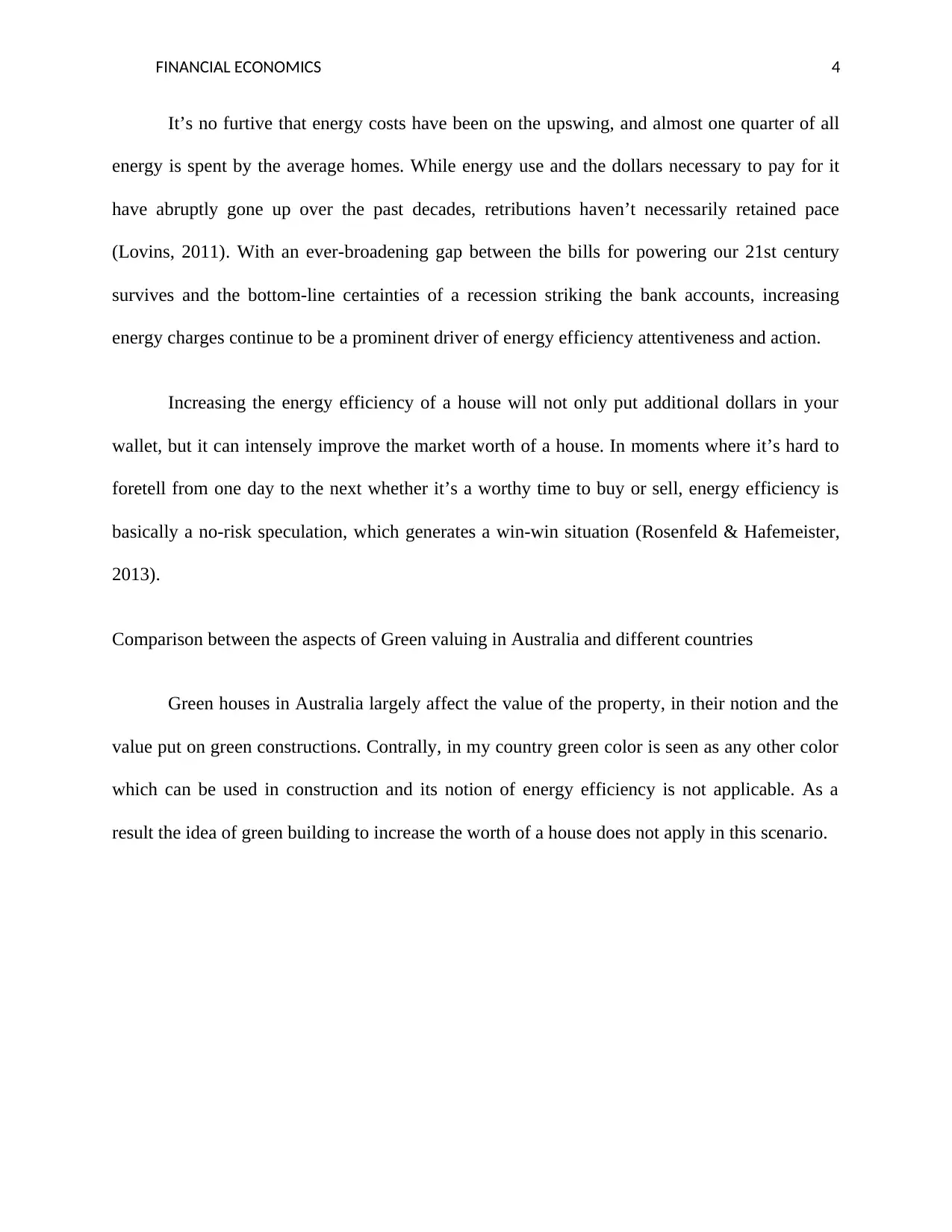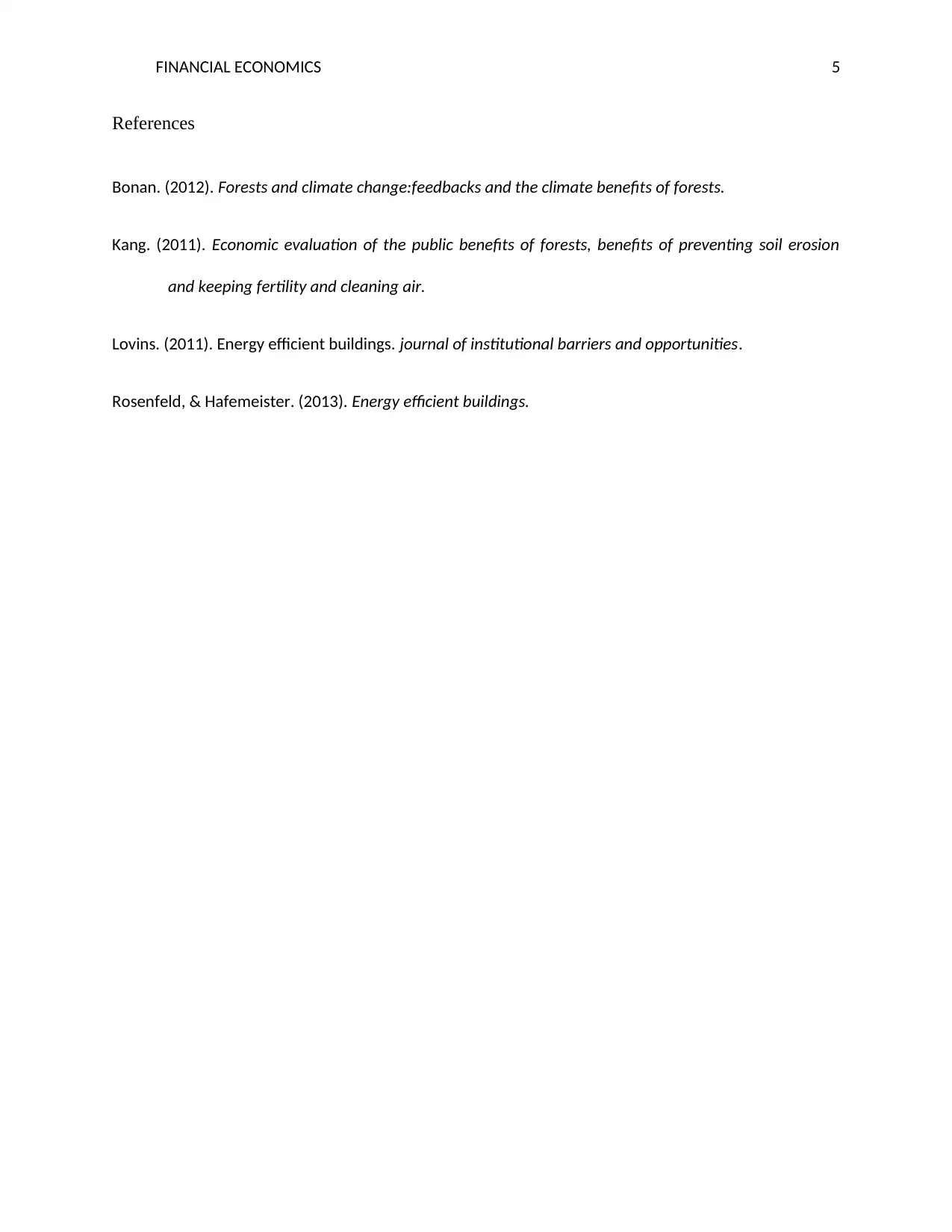Economics and Finance: Forests, Energy Efficiency, Green Valuing
VerifiedAdded on 2020/03/16
|5
|903
|37
Report
AI Summary
This report delves into the economic significance of forests, focusing on their role in water purification and carbon regulation, crucial aspects for human life. It then explores the financial advantages of energy-efficient construction, emphasizing the increasing market value of homes with such features, especially in the context of rising energy costs. The report also provides a comparison between green building valuation in Australia and other countries. It highlights the importance of forest conservation, suggesting methods like monitoring forest sanctions, reforestation, and controlled tree clearing to quantify the benefits of forests. The report also provides a comparative analysis of green building valuation in Australia and different countries, providing insights into the varying perspectives and applications of green building practices.

Running head: ECONOMICS AND FINANCE
ECONOMICS AND FINANCE
Name
Institution
Professor
Course
Date
ECONOMICS AND FINANCE
Name
Institution
Professor
Course
Date
Paraphrase This Document
Need a fresh take? Get an instant paraphrase of this document with our AI Paraphraser

FINANCIAL ECONOMICS 2
Introduction
We depend on forests for our existence, from the oxygen we breathe to the wood we
utilize. Apart from giving habitats to creatures and occupations for people, forests likewise offer
clean watershed security, forestall soil erosion and control environmental change. Among these
benefits evident, this paper tackles two of the major advantages of forests to health human life.
Water purification
Forested areas usually offer higher quality water than the watersheds under other land
uses, if only because fundamentally all the other alternatives like agriculture, manufacturing
sectors and settlement will probably increase the amount of pollutants released into headwaters
(Bonan, 2012). Quality can also be greater because forests sometimes assist to control soil
erosion and decrease sediment load, although the degree and implication of this function will
always vary.
Uninterrupted forests with understorey, leaf clutter and healthily augmented soil is the
best crunch land shield for reducing soil erosion by water. While forests are less capable to
control some pollutants (Kang, 2011), in many circumstances the presence of forests can
significantly decline the necessity for treatment for consumption water and thus profoundly
reducing expenses of distributing water.
Carbon regulation in the atmosphere
Forests are imperative carbon pools which constantly exchange carbon (IV) oxide with
the atmosphere, due to both ordinary processes and human activities (Rosenfeld & Hafemeister,
Introduction
We depend on forests for our existence, from the oxygen we breathe to the wood we
utilize. Apart from giving habitats to creatures and occupations for people, forests likewise offer
clean watershed security, forestall soil erosion and control environmental change. Among these
benefits evident, this paper tackles two of the major advantages of forests to health human life.
Water purification
Forested areas usually offer higher quality water than the watersheds under other land
uses, if only because fundamentally all the other alternatives like agriculture, manufacturing
sectors and settlement will probably increase the amount of pollutants released into headwaters
(Bonan, 2012). Quality can also be greater because forests sometimes assist to control soil
erosion and decrease sediment load, although the degree and implication of this function will
always vary.
Uninterrupted forests with understorey, leaf clutter and healthily augmented soil is the
best crunch land shield for reducing soil erosion by water. While forests are less capable to
control some pollutants (Kang, 2011), in many circumstances the presence of forests can
significantly decline the necessity for treatment for consumption water and thus profoundly
reducing expenses of distributing water.
Carbon regulation in the atmosphere
Forests are imperative carbon pools which constantly exchange carbon (IV) oxide with
the atmosphere, due to both ordinary processes and human activities (Rosenfeld & Hafemeister,

FINANCIAL ECONOMICS 3
2013). Appreciating forests' contribution in the greenhouse influence requires a well indulgent of
the carbon cycle at the forest point. Organic matter holds carbon vulnerable to be oxidized and
reverted to the atmosphere in the state of carbon (IV) oxide.
Carbon is set up in several lochs in the forest: vegetation: existing plant biomass
comprising of wood and non-wood constituents. Although the open part of the plant is the most
evident, the under-ground biomass must also be reflected (Kang, 2011). The quantity of carbon
in the biomass fluctuates from between 35% to 65% of the dry weight .Dead wood and litter:
Numb plant biomass, made up of plant remains (Bonan, 2012).
Quantifying such benefits
Considering these essential paybacks of forests, it is of much significance to take
measures aimed at quantifying these benefits and one of the major ventures towards this step is
Forest Conservation (Kang, 2011). Several methods which can be used to achieve this objective
are; stern monitoring over forest sanction for Agronomic and Flabitation Dedications,
Reforestation and Afforestation, Structured and Planned clearing of Trees and regulations over
forest fires.
Energy efficient construction vs the house value
Credit to the insistent surge in energy charges and the escalating environmental
consciousness of the typical homeowner, making energy efficient improvements to houses can
pay off in subordinate monthly costs and a developed market value for homes (Rosenfeld &
Hafemeister, 2013). It just might be the time to find out in what way increasing a house’s energy
effectiveness can pay surpluses when it comes to the general value of a house.
2013). Appreciating forests' contribution in the greenhouse influence requires a well indulgent of
the carbon cycle at the forest point. Organic matter holds carbon vulnerable to be oxidized and
reverted to the atmosphere in the state of carbon (IV) oxide.
Carbon is set up in several lochs in the forest: vegetation: existing plant biomass
comprising of wood and non-wood constituents. Although the open part of the plant is the most
evident, the under-ground biomass must also be reflected (Kang, 2011). The quantity of carbon
in the biomass fluctuates from between 35% to 65% of the dry weight .Dead wood and litter:
Numb plant biomass, made up of plant remains (Bonan, 2012).
Quantifying such benefits
Considering these essential paybacks of forests, it is of much significance to take
measures aimed at quantifying these benefits and one of the major ventures towards this step is
Forest Conservation (Kang, 2011). Several methods which can be used to achieve this objective
are; stern monitoring over forest sanction for Agronomic and Flabitation Dedications,
Reforestation and Afforestation, Structured and Planned clearing of Trees and regulations over
forest fires.
Energy efficient construction vs the house value
Credit to the insistent surge in energy charges and the escalating environmental
consciousness of the typical homeowner, making energy efficient improvements to houses can
pay off in subordinate monthly costs and a developed market value for homes (Rosenfeld &
Hafemeister, 2013). It just might be the time to find out in what way increasing a house’s energy
effectiveness can pay surpluses when it comes to the general value of a house.
⊘ This is a preview!⊘
Do you want full access?
Subscribe today to unlock all pages.

Trusted by 1+ million students worldwide

FINANCIAL ECONOMICS 4
It’s no furtive that energy costs have been on the upswing, and almost one quarter of all
energy is spent by the average homes. While energy use and the dollars necessary to pay for it
have abruptly gone up over the past decades, retributions haven’t necessarily retained pace
(Lovins, 2011). With an ever-broadening gap between the bills for powering our 21st century
survives and the bottom-line certainties of a recession striking the bank accounts, increasing
energy charges continue to be a prominent driver of energy efficiency attentiveness and action.
Increasing the energy efficiency of a house will not only put additional dollars in your
wallet, but it can intensely improve the market worth of a house. In moments where it’s hard to
foretell from one day to the next whether it’s a worthy time to buy or sell, energy efficiency is
basically a no-risk speculation, which generates a win-win situation (Rosenfeld & Hafemeister,
2013).
Comparison between the aspects of Green valuing in Australia and different countries
Green houses in Australia largely affect the value of the property, in their notion and the
value put on green constructions. Contrally, in my country green color is seen as any other color
which can be used in construction and its notion of energy efficiency is not applicable. As a
result the idea of green building to increase the worth of a house does not apply in this scenario.
It’s no furtive that energy costs have been on the upswing, and almost one quarter of all
energy is spent by the average homes. While energy use and the dollars necessary to pay for it
have abruptly gone up over the past decades, retributions haven’t necessarily retained pace
(Lovins, 2011). With an ever-broadening gap between the bills for powering our 21st century
survives and the bottom-line certainties of a recession striking the bank accounts, increasing
energy charges continue to be a prominent driver of energy efficiency attentiveness and action.
Increasing the energy efficiency of a house will not only put additional dollars in your
wallet, but it can intensely improve the market worth of a house. In moments where it’s hard to
foretell from one day to the next whether it’s a worthy time to buy or sell, energy efficiency is
basically a no-risk speculation, which generates a win-win situation (Rosenfeld & Hafemeister,
2013).
Comparison between the aspects of Green valuing in Australia and different countries
Green houses in Australia largely affect the value of the property, in their notion and the
value put on green constructions. Contrally, in my country green color is seen as any other color
which can be used in construction and its notion of energy efficiency is not applicable. As a
result the idea of green building to increase the worth of a house does not apply in this scenario.
Paraphrase This Document
Need a fresh take? Get an instant paraphrase of this document with our AI Paraphraser

FINANCIAL ECONOMICS 5
References
Bonan. (2012). Forests and climate change:feedbacks and the climate benefits of forests.
Kang. (2011). Economic evaluation of the public benefits of forests, benefits of preventing soil erosion
and keeping fertility and cleaning air.
Lovins. (2011). Energy efficient buildings. journal of institutional barriers and opportunities.
Rosenfeld, & Hafemeister. (2013). Energy efficient buildings.
References
Bonan. (2012). Forests and climate change:feedbacks and the climate benefits of forests.
Kang. (2011). Economic evaluation of the public benefits of forests, benefits of preventing soil erosion
and keeping fertility and cleaning air.
Lovins. (2011). Energy efficient buildings. journal of institutional barriers and opportunities.
Rosenfeld, & Hafemeister. (2013). Energy efficient buildings.
1 out of 5
Your All-in-One AI-Powered Toolkit for Academic Success.
+13062052269
info@desklib.com
Available 24*7 on WhatsApp / Email
![[object Object]](/_next/static/media/star-bottom.7253800d.svg)
Unlock your academic potential
Copyright © 2020–2025 A2Z Services. All Rights Reserved. Developed and managed by ZUCOL.
